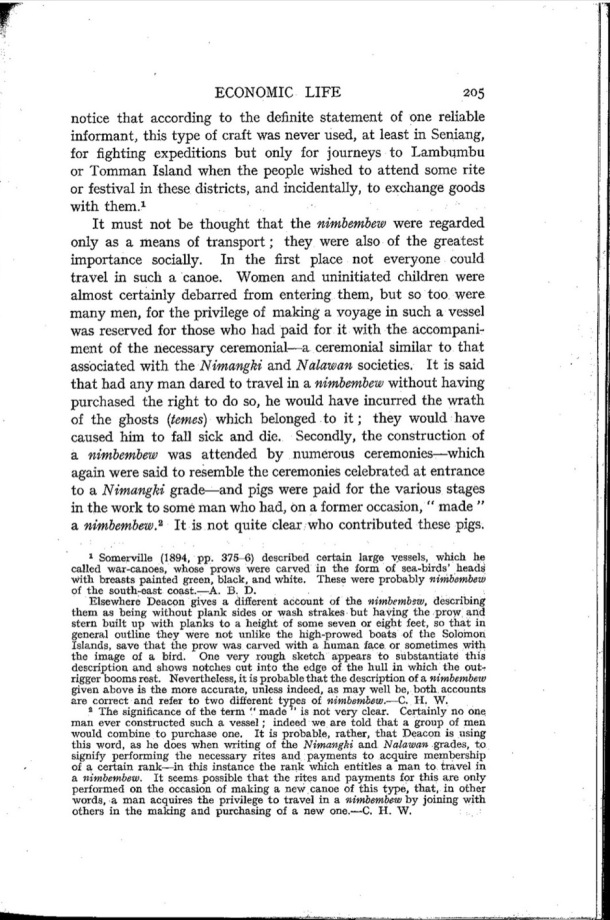|
|  [Note: this transcription was produced by an automatic OCR engine]
ECONOMIC LIFE 205
notice that according to the deï¬Ånite statement of one reliable
informant, this type of craft was never used, at least in Seniang,
for ï¬Åghting expeditions but only for journeys to Lambumhu
or Tomman Island when the people wished to attend some rite
or festival in these districts, and incidentally, to exchange goods
with them.‘
It must not be thought that the nimbembew were regarded
only as a means of transport; they were also of the greatat
importance socially. In the ï¬Årst place not everyone could
travel in such a canoe. Women and uninitiated children were
almost certainly deharred from entering them, but so too were
many men, for the privilege of making a voyage in such a vessel
was reserved for those who had paid for it with the accompani-
ment of the necessary ceremonial—a ceremonial similar to that
associated with the Nimangki and Nalau/an societies. It is said
that had any man dared to travel in a nimbembzw without having
purchased the right to do so, he would have incurred the wrath
of the ghosts (temes) which belonged to it; they would have
caused him to fall sick and die. Secondly, the construction of
a nimbembew was attended by numerous ceremonies—which
again were said to resemble the ceremonies celebrated at entrance
to a Nimzmgki grade—and pigs were paid for the various stages
in the work to some man who had, on a former occasion, " made "
a m'mbembew.' It is not quite clear who contributed these pigs.
1 Sornerville [lE94, pp. avs 0) described certain largo veluels. which hc
ccllcrl war-canoes, whose prows were carved in the icnn cl sea-birds’ heads
with breast: painted green, black. II-‘id white. rhcic wcrc prchchly nimlumbalu
cl the south-east cooet.—A. E. D.
Elsewhere Deacon gives a diflerent account of the nimbembsw. describing
mun an being without plank Slit! or wash strokes but having the prnw and
stern built up wiui planks to a height of some seven or eight feet, :0 that in
gcncrcl outline they were not unlike the lughprcwrn boats of the sclcrucu
Iclnndr, save one mu prow was carved with n human lace or sometimes with
the image of c bird. One very rpngh sketch nppcnru to substantiate this
description and shows notches cut into the edge of the hull in which the out-
rigger hccnic rest. Nevertheless, it is probable that the description at i Mmbambarv
given ahhve is the more accurate, unless indeed, as may well he, both accounts
are correct nun ruicr to twn diflerent types oi m'mb:mbMa.———C. H. w.
The signiï¬Åcance ci the term ~ made ' is not vary clccr. Certainly no one
rnnn ever constructed such a. vessel; indeed we are told that a group ol men
would combine to purchase nnc. It is probable, rather, that Deacon is using
this word. as he does when writing of the Nimanglli and Nulau/an grades, to
npniiy pcricrniin; the necessary rites and payments to acquire membership
oi a certain rnnlr-in this instance the rank which entitles a man to tn!-vel in
a nimbnnbaw. lt seems possible that the rites nnc payments icr this crc only
performed on the occasion of making n new canoe of this type, um, in other
Words, a innn acquires the privilege to travel in a ninlbnmbaw by joining with
others in the making and purchasing oi a new cnc.-c. H. w.
Z’ ,..._,._ _ - _
|